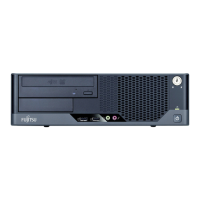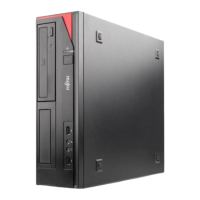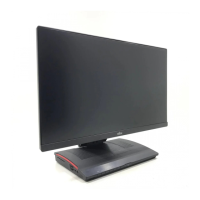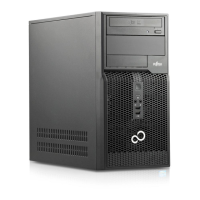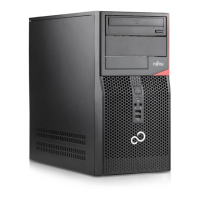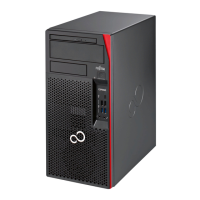
Do you have a question about the Fujitsu ESPRIMO E5730 and is the answer not in the manual?
| Tcase | 74.1 °C |
|---|---|
| Bus type | FSB |
| Stepping | M0 |
| Processor cache | 3 MB |
| Processor cores | 2 |
| Processor model | E7300 |
| System bus rate | - GT/s |
| Processor family | Intel® Core™2 Duo |
| Processor series | Intel Core 2 Duo E7000 Series |
| Processor socket | LGA 775 (Socket T) |
| Processor codename | Wolfdale |
| Processing Die size | 82 mm² |
| Processor frequency | 2.66 GHz |
| Processor cache type | L2 |
| Processor lithography | 45 nm |
| Processor manufacturer | Intel |
| Processor front side bus | 1066 MHz |
| Processor operating modes | 64-bit |
| ECC supported by processor | No |
| Thermal Design Power (TDP) | 65 W |
| Number of processors installed | 1 |
| CPU multiplier (bus/core ratio) | 10 |
| Number of Processing Die Transistors | 228 M |
| Internal memory | 2 GB |
| Memory clock speed | 800 MHz |
| Internal memory type | DDR2-SDRAM |
| Memory layout (slots x size) | 2 x 1 GB |
| HDD speed | 7200 RPM |
| HDD interface | SATA II |
| Optical drive type | DVD Super Multi |
| Total storage capacity | 250 GB |
| Discrete graphics card model | Intel® GMA 4500M |
| Maximum graphics card memory | 0.256 GB |
| Audio system | High Definition Audio Realtek ALC 663 |
| Product type | PC |
| Password protection type | BIOS |
| Bundled software | Nero Essentials |
| Operating system installed | Windows Vista Business |
| Optional operating system supplied | Windows XP Professional |
| Microphone in | Yes |
| USB 2.0 ports quantity | 12 |
| Compatibility | DMI 2.0 PC 2001 WMI 1.5 |
| External drive bays | 1 x 3.5\ |
| Internal drive bays | 1 x 3.5\ |
| Networking features | Gigabit LAN |
| Chassis type | SFF |
| Cable lock slot type | Kensington |
| Certification | CE FCC Class B UL CSA RoHS WEEE |
| Operating temperature (T-T) | 15 - 35 °C |
| Power supply | 270 W |
| Processor code | SLAPB |
| Processor ARK ID | 36463 |
| Processor package size | 37.5 x 37.5 mm |
| Depth | 380 mm |
|---|---|
| Width | 340 mm |
| Height | 100 mm |
| Weight | 10000 g |
Explains symbols and formatting conventions used in the manual for clarity and understanding.
Covers essential safety guidelines for handling, transporting, and cleaning the device.
Details CE marking, energy saving, disposal, and regulatory compliance statements.
Provides FCC Class B compliance and other regulatory statements for device operation.
Instructions for unpacking, checking delivery, and performing initial setup steps.
Guidance on setting up the device physically and connecting external hardware.
Detailed steps for connecting monitors, keyboards, mice, and power.
Explanation of device indicators and the initial software installation process.
Guide on installing the operating system and other necessary software.
Procedures for switching the device on, off, and handling battery discharge scenarios.
Details on keyboard layout, important keys, and key combinations for operation.
Covers BIOS setup, property protection, mechanical casing lock, and anti-theft measures.
Information on access authorization using SmartCards and SystemLock security.
Guidance on initial problem resolution and installing new software.
Troubleshooting steps for unlit indicators and problems switching the device on/off.
Solutions for blank screens and incorrect monitor settings.
Addresses issues with mouse pointers, floppy disks, time/date, and error messages.
Instructions for restoring hard disk contents and general troubleshooting tips.
Guidelines for handling internal boards, opening/closing the casing, and connectors.
Steps for installing and removing floppy, hard, and other drives.
Instructions for installing optional SmartCard readers and WLAN modules.
Guidance on upgrading main memory and replacing the system processor.
Procedure for replacing the system's lithium battery to maintain CMOS data.
Details electrical specifications, operating voltage, and environmental conditions.
Provides width, depth, height, and weight specifications for the device.
Specifies required clearance for adequate ventilation to prevent overheating.
